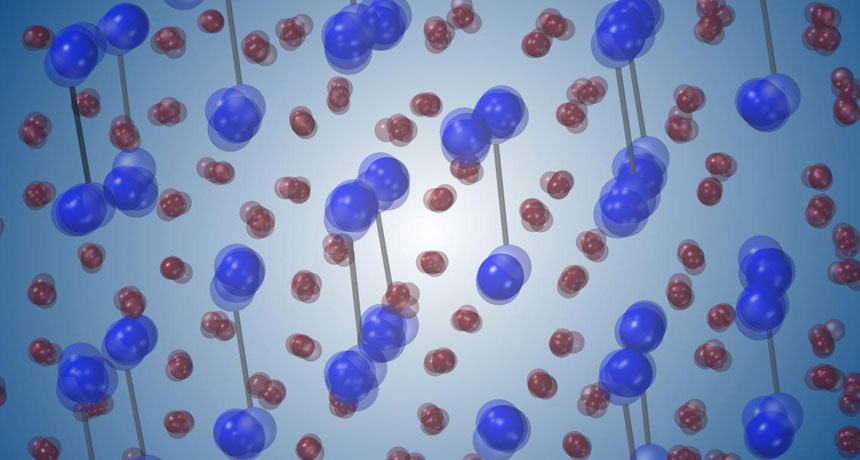
JUMBLED UP When hit with laser light, vanadium atoms (blue in this illustration) and oxygen atoms (red) in vanadium dioxide reorganize into a new crystal structure. The atoms’ movements during this change are much more disorderly than expected.
Delaire group/Duke University
- More than 2 years ago
For the first time, researchers have gotten a detailed view of how atoms in a compound called vanadium dioxide move when an ultrafast laser pulse transforms the material from an electrical insulator to a conductor — and it’s nothing like scientists expected.
Rather than switching from one crystal formation to another in a direct, synchronized manner, like choreographed ballerinas, the atoms shift around in a disordered manner, more like clumsy partygoers doing the Cha Cha Slide. This new insight into the inner workings of vanadium dioxide, reported in the Nov. 2 Science, may inform engineers who are trying to harness the dual nature of the compound and others like it for new technologies.
Scientists have been fascinated for decades by the nature of vanadium dioxide’s insulator-to-metal transition, which happens when the material is heated above about 67° Celsius or hit with an ultrafast laser pulse. But that electrical about-face is difficult to study, because it happens in about 150 femtoseconds, or quadrillionths of a second.
Other experiments that involved tickling vanadium dioxide’s atoms with laser light have measured only the average motions of atoms during this transformation. These general trends suggested a smooth shift from one crystal formation to another, but were not detailed enough to reveal small deviations in the atoms’ movement.
Mariano Trigo, a physicist at SLAC National Accelerator Laboratory in Menlo Park, Calif., and colleagues got a closer look at the compound using ultrashort pulses of X-ray radiation. After hitting a sample of vanadium dioxide with a superfast flash of laser light to trigger its insulator-to-metal transition, the researchers zapped the compound with a series of X-ray pulses, each a few tens of femtoseconds long.
This X-ray radiation scattered off atoms in the material, revealing the particles’ positions at the time of each pulse, explains study coauthor Olivier Delaire, a materials scientist at Duke University. The pulses were so rapid and intense that they tracked atoms’ movements much more precisely, and at shorter time intervals, than other experiments.
“It’s extremely cool” to see these atomic motions in such fine detail, says Ralph Ernstorfer, a physicist at the Fritz Haber Institute of the Max Planck Society in Berlin not involved in the study.
These atomic snapshots exposed the vanadium atoms’ discombobulated movement from one crystal structure to the next. Supercomputer simulations of vanadium atoms rejiggering themselves in this way reproduced almost the exact same X-ray scattering patterns as the experiment.
Vanadium dioxide’s ultrafast insulator-to-metal transition may someday form the basis of super speedy electronic components, or devices that exploit vanadium dioxide’s weird relationship with light and electricity for camouflage or efficient heating and cooling (SN Online: 10/25/13). Understanding this material’s internal structure could help engineers wrest better control over its properties, says Richard Averitt, a physicist at the University of California, San Diego not involved in the work.
The technique Trigo’s team used to investigate vanadium dioxide may also help researchers probe other materials that change characteristics under the influence of laser light, Averitt says. These may include materials that switch magnetic properties or become superconductors that transmit electricity with no resistance. “It’s got a very bright future” for revealing the atomic goings-on in such two-faced materials, he says.







